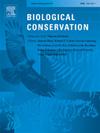保护连通性,减轻气候和土地覆盖物变化对婆罗洲的影响
IF 4.9
1区 环境科学与生态学
Q1 BIODIVERSITY CONSERVATION
引用次数: 0
摘要
加强保护区之间的连通性对于促进物种的分布范围变化以应对气候变化至关重要。然而,这种连通性的空间规划往往忽视了气候和土地覆被变化的综合影响,尤其是在热带地区,因为栖息地的丧失对生物多样性的威胁更为直接。我们探讨了保护区之间连通性的必要性,以减轻婆罗洲气候和土地覆被变化的双重影响。利用栖息地适宜性模型以及气候和土地覆盖物变化综合预测,我们建立了当前和未来情景下的连通性模型,为 81 个物种确定了保护区之间的最佳连通性。通过考虑恢复成本和机会经济成本,我们还探索了实施连接计划的成本效益权衡。不同物种的连接解决方案各不相同,但往往趋同于保护区之间的相同连接,当代的连接穿越 6 到 40 公里,平均包括 67% 的森林覆盖率。到 20 世纪 80 年代,连接点的数量会减少,虽然许多连接点的长度更短,但其栖息地的质量也更差,这反映了森林覆盖率和物种分布的减少。因此,在 2080 年,在保护区之间建立走廊的经济成本估计比 2020 年高出 65%。我们的分析突出表明,迫切需要尽早优先考虑连通性干预措施,以便为面临气候变化干扰的多种物种带来最大的长期利益,同时最大限度地降低成本。然而,由于森林退化和损失率高,热带地区的保护规划非常复杂。在更精细的空间尺度上实施我们的方法有助于确定具有成本效益的区域,优先考虑景观连通性,从而在不断变化的环境条件下保护热带生物多样性。本文章由计算机程序翻译,如有差异,请以英文原文为准。
Connectivity conservation to mitigate climate and land-cover change impacts on Borneo
Enhancing connectivity between protected areas is crucial for facilitating species range shifts in response to climate change. Yet spatial planning for this connectivity often overlooks the combined impacts of climate and land-cover change, particularly in tropical regions where habitat loss is a more immediate biodiversity threat.
We explore the need for connectivity between protected areas to mitigate the dual impacts of climate- and land-cover change on Borneo. Using habitat suitability models and combined climate and land-cover change forecasts, we develop connectivity models for present and future scenarios, identifying optimal connections between protected areas for 81 species. By considering restoration and opportunity economic costs, we also explore the cost-benefit trade-offs of implementing connectivity plans.
Connectivity solutions varied among species, but often converged on the same connections between protected areas, with contemporary connections traversing 6 to 40 km and comprising 67 % forest cover, on average. By the 2080s there were fewer connections, and while many were shorter, they also comprised poorer quality habitat, reflecting reductions in forest cover and species distributions. As a result, the economic cost of creating corridors between protected areas was estimated to be 65 % higher in 2080 than in 2020.
Our analysis highlights the urgent need to prioritize connectivity interventions early to maximize long-term benefits for multiple species facing climate-change disruption while minimizing costs. However, conservation planning in tropical regions is complex, given high rates of forest degradation and loss. Implementing our approach at finer spatial scales could help identify cost-effective areas to prioritize landscape connectivity, helping safeguard tropical biodiversity amid changing environmental conditions.
求助全文
通过发布文献求助,成功后即可免费获取论文全文。
去求助
来源期刊

Biological Conservation
环境科学-环境科学
CiteScore
10.20
自引率
3.40%
发文量
295
审稿时长
61 days
期刊介绍:
Biological Conservation is an international leading journal in the discipline of conservation biology. The journal publishes articles spanning a diverse range of fields that contribute to the biological, sociological, and economic dimensions of conservation and natural resource management. The primary aim of Biological Conservation is the publication of high-quality papers that advance the science and practice of conservation, or which demonstrate the application of conservation principles for natural resource management and policy. Therefore it will be of interest to a broad international readership.
 求助内容:
求助内容: 应助结果提醒方式:
应助结果提醒方式:


